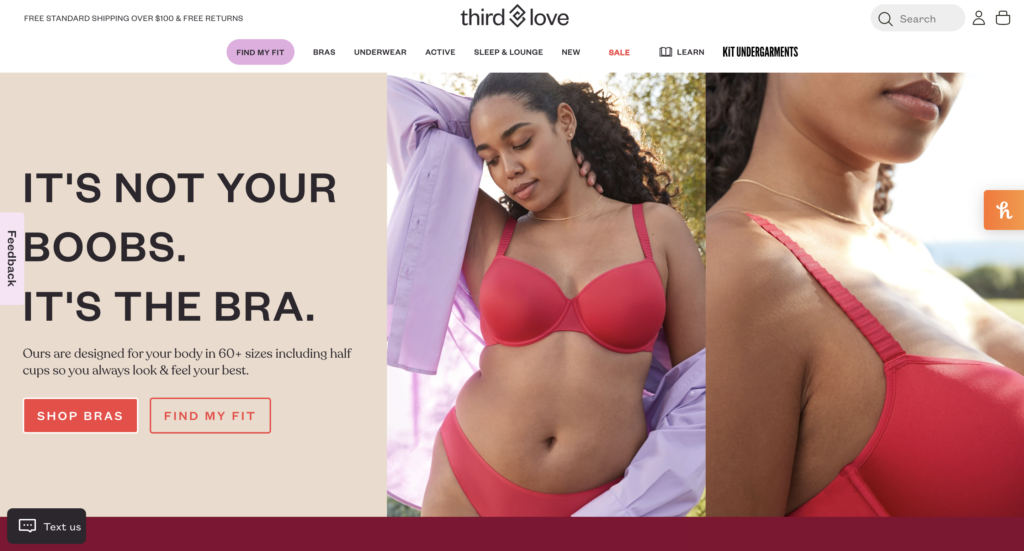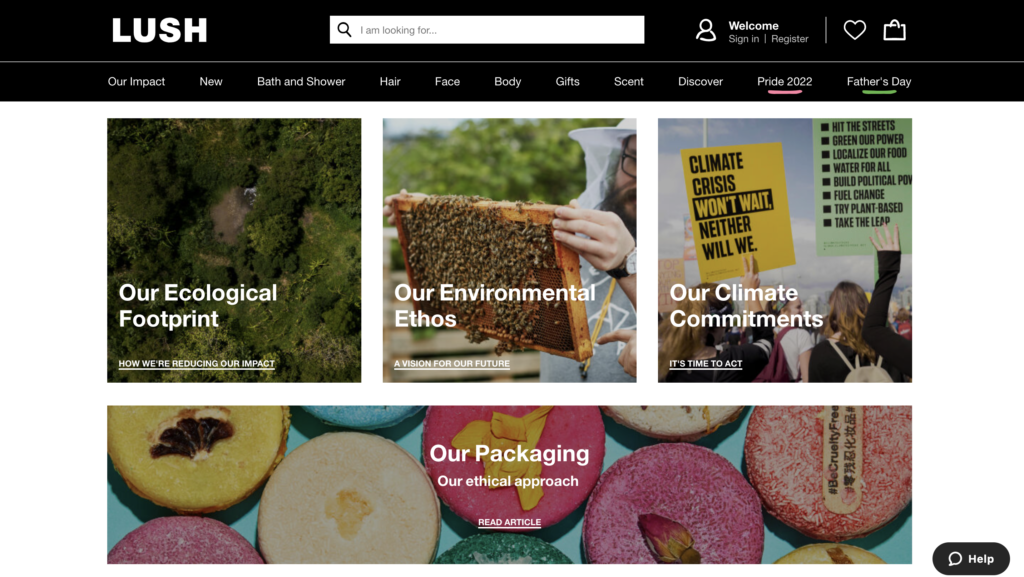When it comes to growing your brand, traditional marketing methods just don’t cut it anymore. Many of today’s most successful brands have turned to growth marketing – and it’s working.
Growth marketing is all about experimenting to disrupt the market and boost your sales. This might look like anything from collecting user data to create better products or personalize the user experience – or even simply doing something that no one else is willing to do (like going dark on social media).
The beauty – and sometimes challenge – of growth marketing is that what works for another brand might not work for you. That’s because you have a different audience with different needs.
In these examples, we’ll show you three different ways growth marketing helped e-commerce brands stand out from the competition and turn disruption into dollars.
1. ThirdLove Created a Viral Moment
ThirdLove is an e-commerce brand that sells bras marketed toward millennial and Gen Z consumers.
The company went viral in 2018 when CEO and founder Heidi Zak penned a public letter to Victoria’s Secret, buying a full-page ad in The New York Times. In the letter, Zak directly called out Victoria’s Secret’s lack of inclusivity in its marketing and its hypersexualization of women in order to sell undergarments.
View this post on Instagram
Source: Instagram.com/ThirdLove
Zak’s move leveraged a traditional form of media to push a growth marketing tactic. Then, that same year, ThirdLove saw a 347% YoY sales growth. This was no accident. When ThirdLove was founded, it was fully aware of the gap in the market: They knew women wanted bras that actually fit.
Its marketing strategy uses language and imagery to show consumers that the company is committed to being different from other competitors (ahem, Victoria’s Secret). Its messaging reinforces the idea that its products are designed for women, regardless of body size.
Source: ThirdLove.com
Just take a look at its Fit Finder, for example. It’s an online quiz that asks for details about how your current bra fits. Then, ThirdLove takes the data and uses it to personalize your perfect fit – and style. The Fit Finder even recommends a few products for you to try.
The Fit Finder was unveiled in 2016 and already has already been completed by 13 million women, giving the company over 600 million data points to help it understand the needs of its consumers. Plus, this information helps guide product development, letting the company improve on customer experience, sizing issues, and fit. It’s no wonder ThirdLove bras have tens of thousands of 5-star reviews on its website.
Because the company was keenly aware of women’s needs to have well-fitting undergarments, it became easy to hyperfocus on viral growth marketing tactics, like The New York Times ad. They could create content they knew would naturally go viral – the demand was that high.
The best part about viral growth marketing is that it catches everyone’s attention, driving traffic to your marketing channels without having to contract with influencers or celebrities.

Extend Your Brand Reach With Influencer Advocates
Let your influencers create new customers. Learn how to access their followers and drive customer-led growth.
Get the Guide2. Lush Decided to Be Anti-social
Cosmetics retailer Lush specializes in handmade, ethically sourced, and cruelty-free products.
The global retailer based in the UK generated a ton of attention quickly because of its emphasis on ethics, sustainability, and recycling.
Source: LushUSA.com
Ethical storytelling, like the messaging Lush presents, is a tactic that resonates with younger generations of consumers, particularly Gen Z. In February 2022, IBM surveyed 16,000 consumers around the world and found that 51% value environmental sustainability. Plus, half of consumers are also willing to pay a premium for a sustainable brand or product.
Lush used this idea of ethical storytelling in its 2021 campaign on Black Friday, “Social Departure,” which announced the company was leaving major social media platforms Instagram, Facebook, Snapchat, and TikTok.
@lushBe Somewhere Else. We want to engage with you in places that look after you and your mental well-being. Read more via the link in our bio.♬ original sound – LUSH
Source: TikTok.com/Lush
Lush has vowed to stay off these platforms until they “can provide a safer environment for their users.” Instead, the company prioritizes other marketing channels like email and word of mouth. Lush’s CEO and co-founder Mark Constantine commented on the move, saying:
I’ve spent all my life avoiding putting harmful ingredients in my products. There is now overwhelming evidence we are being put at risk when using social media. I’m not willing to expose my customers to this harm, so it’s time to take it out of the mix.
If the idea of completely going dark on the biggest social media platforms sounds radical, you’re not alone: Lush’s move is counter to most companies’ marketing strategies, considering that 3.96 billion people use social media.
And the move didn’t come without risk. The company took an estimated £10 million ($13.3 million) hit as a result. Then, COVID made a bigger deficit. As of EOY 2021, its sales are still slightly lower than pre-pandemic levels, but they are steadily climbing back to a profitable place, seeing a £74.4m increase in profits from the year prior.
Taking such a big stance enabled the company to review its financial procedures and fix outdated practices, giving them a more “profitable business model” for the future.
Lush’s example proves that taking a calculated risk often pays off in the long run. Yes, the company saw a decline in sales, but it has refined its practices and cultivated a more loyal audience that’s aligned with its ethos.
3. Spotify Wrapped Up Loyalty With Personalization
Spotify is one of the most popular audio streaming and media apps in the world, with a reported 422 million monthly active users as of Q1 in 2022.
In 2013, Spotify first conceived what would become “Wrapped.” It was released to the public as the “Year in Music” in 2015 and went viral as the Wrapped we know today in 2017, giving users a personal but also universal listening experience.
Source: Spotify
The way it works is pretty simple. All year long, Spotify collects data on each user’s listener experience, like top artists, top songs, favorite genres, and more, and presents them in groovy, interactive slides each December. It makes the user feel cool, relevant, and tapped into the cultural zeitgeist.
Perhaps most importantly, Wrapped is shareable. Now, anyone can pass along their top artists of the year to their friends or post on their Instagram stories. In 2020 alone, Spotify saw a 21% increase in app downloads during the first week of December, according to Protocol.
Plus, you can connect to a friend’s account, and Spotify will combine your data, showing you exactly where you both align in your music preferences and where you diverge.
Source: Spotify
Each year, Spotify announces the release of Wrapped with a series of quirky billboards designed in-house. These ads highlight some of the biggest musical artists, podcast hosts, and listening trends of the year, often with a humous effect.
Source: AdAge
Plus, in 2020, Spotify partnered with the National Independent Venue Association (NIVA) to help venues struggling to stay afloat in the wake of COVID. NIVA asked the venues to place funny, inspirational messaging on their marques and received a donation from Spotify.
Source: AdAge
These advertising campaigns are a strong example of how a company can use traditional methods in combination with experimental marketing to fuel growth.
The secret to Wrapped’s success is that they found a way to maximize their user data. Most, if not all, brands collect user data to enhance experiences. Spotify just found a way to take that data and put the most popular listener trends on well-designed slides for you to enjoy.
Manage Your Strategy With a Growth Marketing Tool
Businesses that want to make the most out of their growth marketing strategy need to invest in a growth marketing tool.
These growth tools, like Extole, are designed to help you manage all aspects of your company’s marketing strategy, including:
- Contracts with influencers
- Payouts for referral customers and brand affiliates
- Special campaigns for your top customers
In a recent economic impact report, Forrester Consulting found that organizations that use Extole see a 282% increased ROI over just three years. Plus, these companies gain twice the number of high-quality customers.
Schedule a demo to learn more.










